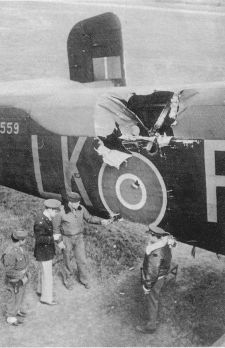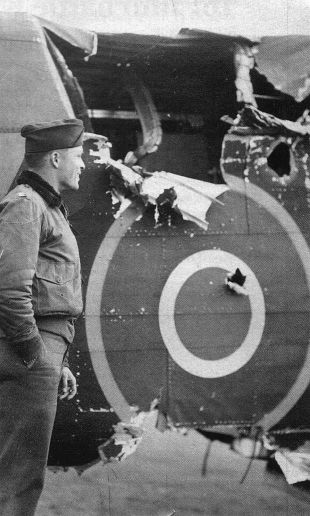
 |
Danger did not come just from Flak or Fighters. Collisions and bombs from higher aircraft presented problems over the conjested target area. The boffins said that the danger was minimal.... But crews knew otherwise. As the crew of MZ599 LK-F were to find out.
Eighteen aircraft took off from Burn on 3rd September 1944, led by Wing Commander A G T James, the newly appointed Squadron Commander, to join the Main Force carrying out a heavy daylight raid on six airfields in southern Holland, 578 Squadron's target being Venlo.
LK-F, was piloted by Flying Officer Bob Davies, this was his recollection:
The weather was good, there was light 'flak' and as far as I could see, no fighter opposition. No sooner had my Canadian bomb aimer, Vernon Corbett, announced that bombs had gone, there was an almighty crash. My first thought was that we had received a direct hit by an anti-aircraft shell. My mid-upper gunner, Charlie Hayward, announced "There's a bloody big hole in the top of the fuselage about ten feet aft of my turret." When the first moments of panic had died down a bit, I found that the aircraft was behaving normally despite the next piece of news "There's an equally big hole in the floor and the Elsan and the flare chute have disappeared through it." A quick crew check revealed that the rear gunner, Sam Brown, was beginning to suffer from lack of oxygen. I told him to leave his turret and plug into an emergency bottle. He declined my suggestion that he jump over the hole and take up his crash position near the main spar. The nature of the damage to our aircraft dictated what we should do next, which was to initiate an SOS call and set course for the coastal crash airfield at Woodbridge. However, as a crew, we had second thoughts, we were all going on leave next day. We decided, unanimously, to cancel the landing and make for Burn. Deteriorating weather forced us to fly lower and lower and, at 800 feet in moderate turbulence and only fifteen minutes from base, we were diverted to Old Buckenham. Back we went on a reciprocal course. The circuit and landing was an anticlimax. Everything came down that should have come down. We taxied to a halt, and a very relieved crew went to debriefing and to their respective messes for a much needed drink. However, for me. Fate had another card to play. At the bar I was approached by a young officer who asked whether he could buy me a drink as he was the bomb aimer of a diverted Lancaster who had watched one of his bombs go through my Halifax. I accepted his hospitality and we shook hands. We both agreed had the Lancaster been flying only a little higher above the Halifax, there would have been time for the wind driven bomb propeller to have spun off, thereby arming the fuse to explode on contact!
Sergeant Alan Ball, Mid-upper gunner of LK-P withness the incident and was lucky to get away:
I was flying in the aircraft positioned immeadiately below LK-F and realising what would happen if we stayed where we were I called the attention of our New Zealand skipper FLight Sergeant Don Connop, only to be blasted by the bomb aimer, Sergeant James Pringle, for daring to interrupt his run up to the target. However the skipper took note of the situation and managed to avoid trouble by his timely action. The falling bombs could be seen quite clearly including the one which went through LK-F.

USAAF staff inspect the damage.

The Halifax was a rugged, repairable machine that could come back with all sorts of battle damage and still live to fly again. MZ559 was not scrapped. A replacement fuselage was shipped to the site and LK-F was repaired to fly another day.

Source:Based at Burn MKII + other sources.
There is a tragic postscript to this story: MZ559 only survived until 18th November 1944. MZ559 was now LK-K. Having completed its mission to Munster, Flying Officer Thomas Evans and crew were circling Burn airfield in very poor visibility awaiting for permission to land when it was involved in a collision with Halifax NR241 of 51 squadron which was returning from the same operation. Both machines crashed to the ground at Cambleforth near Selby, all members of both crews lost their lives.